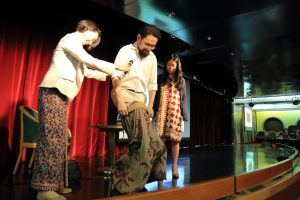[103rd Cruise Report]The Hiostory of Batic Fabric Mr. Farish・A・Noor
Jan.2nd
The Hiostory of Batic Fabric Mr. Farish・A・Noor (Political Scientist, Associate Professor of International Studies in Singapore Nanyang Technological University)

Mr. Farish. A. Noor, a guest educator, is a dean of doctoral programs of history degrees in Singapore Nanyang Technological University. Today, he told us aboout the history of “Batic Fabric” which he himself likes to collect. “Batic” is a type of fabrics well-spread all over South East Asia, and was fist produced in Java island few hundred years ago. It is a part of the World Intangible Cultural Heritages in Indonesia where our ship is calling at tomorrow. It is a fabric dyed with wax. In Indonesia, “Nbatik” means to write, and the fabric’s design is written with candle pens. It takes about 6 moths to make the fabric by hand, so it is more common to produce it with machines nowadays. For Indonesian people, Batic has a strong implication of spirituality and religion, and it is said that one’s social class can be known by taking a look at his Batik. Also, Batik’s design and motif portray tremendously Indonesia’s historical background, so the fabrics are valued as ancient documents. Moreover, there is another important fact regarding Batik. It is the fact that 90% of the makers are female. Production of Batik has a strong influence on women’s income, and also, it is kept respectful as a way of women’s expression. It is indeed women who left a note of history through Batik, or so they say.

In the present day, there are all kinds of Batik, and some Batik have Disney character designs. Some people have negative opinions toward the Disney ones, but on the other hand it shows the flexibility of Indonesian cultural characters. From the ancient time, Indonesia has prospered as a transit trading spot. While all kinds of items are being exchanged, Batik has remained and preserved its tradition by accepting new and developing with new. “We might encounter brand new Batic we have never seen before in the future,” said Mr. Farish. “As a collector, how do you store your Batik collection?”, “Please tell us the correlation of Batik and gender equality?” During Q&A session, a lot of questions were asked from the audience. It is about time we arrived at Bali island of Indonesia tomorrow. Now that we attended the lecture, we might be able to see Batic fabrics from a different perspective.
